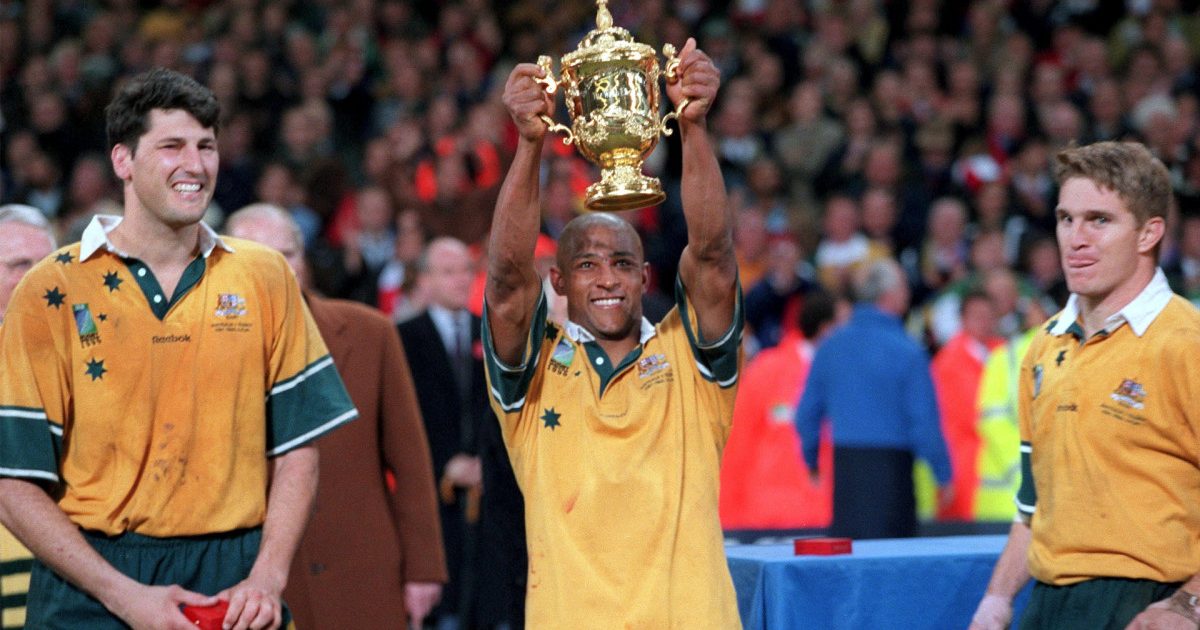Scrum half (Halfback) - Position Guide

The scrum half is the heartbeat of a rugby union team. Responsible for making decisions, linking play, throwing key passes and kicking accurately, the rugby scrum half must have a wide skill set that they can execute to perfection.
Generally one of the smallest players on the pitch, anyone who plays at the scrum half position must have an excellent rugby brain and an uncanny ability to execute their skills perfectly under pressure.
Think you have what it takes to play as a rugby scrum half? In this guide, you’ll find everything you could possibly need to know about the position and the skills that are required.
What is a scrum half?
The scrum half operates as a link between the forwards and the backs.
No player dictates how a game is managed as much as the scrum half does. This is because anyone in the scrum half position must not only have a rounded technical skill set, but they must also make the right decision every time.
Most known for their passing game, rugby scrum halves must also be able to control territory with their kicks and provide exceptional support play.
Due to their slight size and build (compared to some of the larger players on the pitch anyway), a scrum half must also possess large amounts of acceleration and speed, so they can evade tackles.
Other names for a scrum half
Around the world, some rugby positions are known by different names. This is the case with the scrum half, who is often known as the half back in the southern hemisphere.
What number is a scrum half?
Players on a rugby union team wear numbers 1-15. Unlike in other sports (such as football/soccer) where a player can choose whichever number they like, a player on a rugby team must wear the number that corresponds to their position. For this reason, the player in the scrum half position always wears the number nine shirt.
What is the average size of a scrum half?
Although this isn’t always the case, the scrum half is often the smallest player on the pitch. That said, the size and weight of the scrum half often has little bearing on how effective the player is at executing their roles and responsibilities.
An incredibly skill-based role, the height of the scrum half is particularly irrelevant. For example, at the elite level of the game you get short scrum halves like Faf de Klerk, who is 1.7m tall, and much taller scrum halves like Conor Murray, who is 1.88m tall.
On average, the weight of a professional scrum half is around 85kg (187lbs). Although the scrum half is one of the smallest players on the pitch, they must still pack a punch. After all, opposition forwards will try to knock a scrum half over as they try to distribute the ball from the base of rucks, scrums and mauls. If a scrum half has a bit of weight and power behind them, then they will find it easier to stand up to this challenge.
What is the scrum half’s role?
The role of the scrum half is incredibly varied. As they’re the link between the forwards and the backs, they play an important role at set pieces. But, players in the scrum half position are also used as ball handlers, kickers and support players. With this in mind, let’s take a look at the role of the scrum half in greater detail.
What is the scrum half’s role in scrums?
When a scrum is formed, the 8 forwards from each team bind together to form their own pack. The two packs then oppose each other by binding together, head to head with a tunnel between the two packs.
At this stage, the scrum half of the team that did not commit the penalty puts the ball into their scrum. If the scrum is executed correctly, their side’s hooker will strike the ball backwards and the ball will move through the scrum towards the feet of the number 8.
Once the number 8 has the ball, the scrum half can then launch a quick attack on their own, combine with the number 8, kick tactically, or whip the ball out to the backs.
Although the team will usually decide what they want to do if they win the ball before the scrum is formed, the scrum itself may not go to plan. As a result, the scrum half may be required to make a decision based on the play in front of them.
While all this is happening, the scrum half of the team that conceded the penalty also has a role to play. They must harass their opposite number and provide defensive cover.
What is the scrum half’s role in lineouts?
Lineouts occur when play is restarted at the touchline. The scrum half is required to take the ball from the person who caught it in the air. Once the ball is gathered, the scrum half can then pass the ball to the backs, who can launch an attack.
However, lineouts can be messy. Often, the ball is fumbled or deflected towards a scrum half. This means that the scrum half must remain calm under pressure and have exceptional hands.
What is the scrum half’s role in open play?
Overall, a scrum half must be an excellent decision maker. It’s usually their job to decide whether to pass the ball straight out to the fly half, box kick the ball, pick and go themselves, or pop the ball away to a forward on a short pass.
In open play, the scrum half must act as the team’s chief distributor and hit moving targets with supreme accuracy.
As the team’s best passer, they must have complete control over the weight of their passes and must be equally as good passing the ball in both directions.On top of this, the scrum half must help their team win the territorial battle.
To do this, a scrum half must be able to kick accurately from behind rucks and mauls (these are known as box kicks). Generally speaking, a scrum half will be asked to make two types of kicks:
Clearance kicks: With these kicks, the objective is to kick the ball either deep into touch or between the two lines of defence towards the blindside. These kicks are usually done when a team is in their own 22-metre area and they’re looking to relieve pressure.
Contestable kicks: The aim of these kicks is to regather possession further up the field. As a result, the scrum half must kick the ball high up into the air (as well as forwards) and generate hang time. This way, their team’s wingers can run and contest for the ball before it drops into the arms of the opposition.
Although the scrum half takes on responsibility for kicking and distribution, they cannot neglect their tackling and defensive responsibilities. As one of the smallest players on the pitch, the scrum half must look to make tackles before the opposition players begin to move, so they can negate their opponent’s size advantage.
The final role of the scrum half in open play is game management. A scrum half is like a general on the pitch, and they must work together with the fly half to ensure the team can attack effectively. Due to this, a scrum half must have an excellent rugby brain and must be able to see the play as it unfolds before them.
Notable scrum halves

Due to their prominence on the field, some of the world’s most recognisable players have featured at the scrum half position.
As part of our recent RugbyPass Hall of Fame fan vote, we asked our readers who they thought was the greatest ever scrum half to play the game. Overall, they almost unanimously told us that All Blacks legend Aaron Smith was the game’s greatest scrum half. He received more than twice as many votes as Fourie du Preez and Joost van der Westhuizen.
FAQs
So, now you know the basics of playing at the scrum half position. If you fancy learning even more about how a scrum half plays and trains, then read our FAQs below.
Do scrum halves kick?
Yes. Although the fly half will take almost all of the kicks from the kicking tee for penalties and conversions, the scrum half is often asked to kick when the ball is in open play.
Scrum halves can choose to kick for touch when their team is under pressure, box kick for territory or send the ball high into the air so their teammates can contest for possession further up the field.
How far does a scrum half run in a game?
Scrum halves are incredibly hard working players who are involved in almost every phase of play. As a result, the demands of the position are exacting. While front row players generally only cover 4.5km of ground during a rugby match, a scrum half will usually run further than all their teammates, and it’s not uncommon for an elite scrum half to run 7km during a game.
What does a scrum half work on in the gym?
Although they don’t need to be as strong and powerful as the forwards, scrum halves must still be muscular and physical players. But, as well as working on building lean muscle, scrum halves must also work on their running ability so they can cover more ground during a game.
When working on building muscle, a scrum half should focus on their shoulders and core. Plus, leg strength also needs attention because stability is required for digging balls out of rucks.
To build these muscles, try the following exercises:
- Overhead presses
- Squats
- Bench-press
- Lunges
- Deadlifts
Of course, to compete in club rugby, nobody is expecting you to be as quick and strong as Faf de Klerk or Conor Murray. However, using these players as benchmarks can give you something to aspire to. With this in mind, at the elite level, a top level scrum half must be able to:
- Squat 1.3x their bodyweight
- Bench-press 1.3x their bodyweight
- Run 3km in 11 mins 15 seconds
- Sprint 40m in less than 5.25 seconds















































What does scrum half do when a ruck is ongoing?
Looks for gaps either side of the ruck, follows his receiver (10) calls and decides to execute pass or do his own thing (go the other side or space in behind). Directs forwards in the ruck, goes in himself if he can see opposition pushing over or about to get hands on ball. Decides if fast ruck ball or ball security is most important that ruck.
What he doesn’t do is point to the ass of a guy in the ruck and tell another of his forwards to bind onto that guy, then role the ball back a bit with this foot and then repeat his the previous step, roll it back some more, then wait for the refs 5 second play count before kicking with his eyes closed over his head. He also doesn’t wait for the opposition tackler to start rising to his feet before trying to pass the ball out directly over his head.
Theres basically more dont’s than does
/thoughts of notmuchahalfback